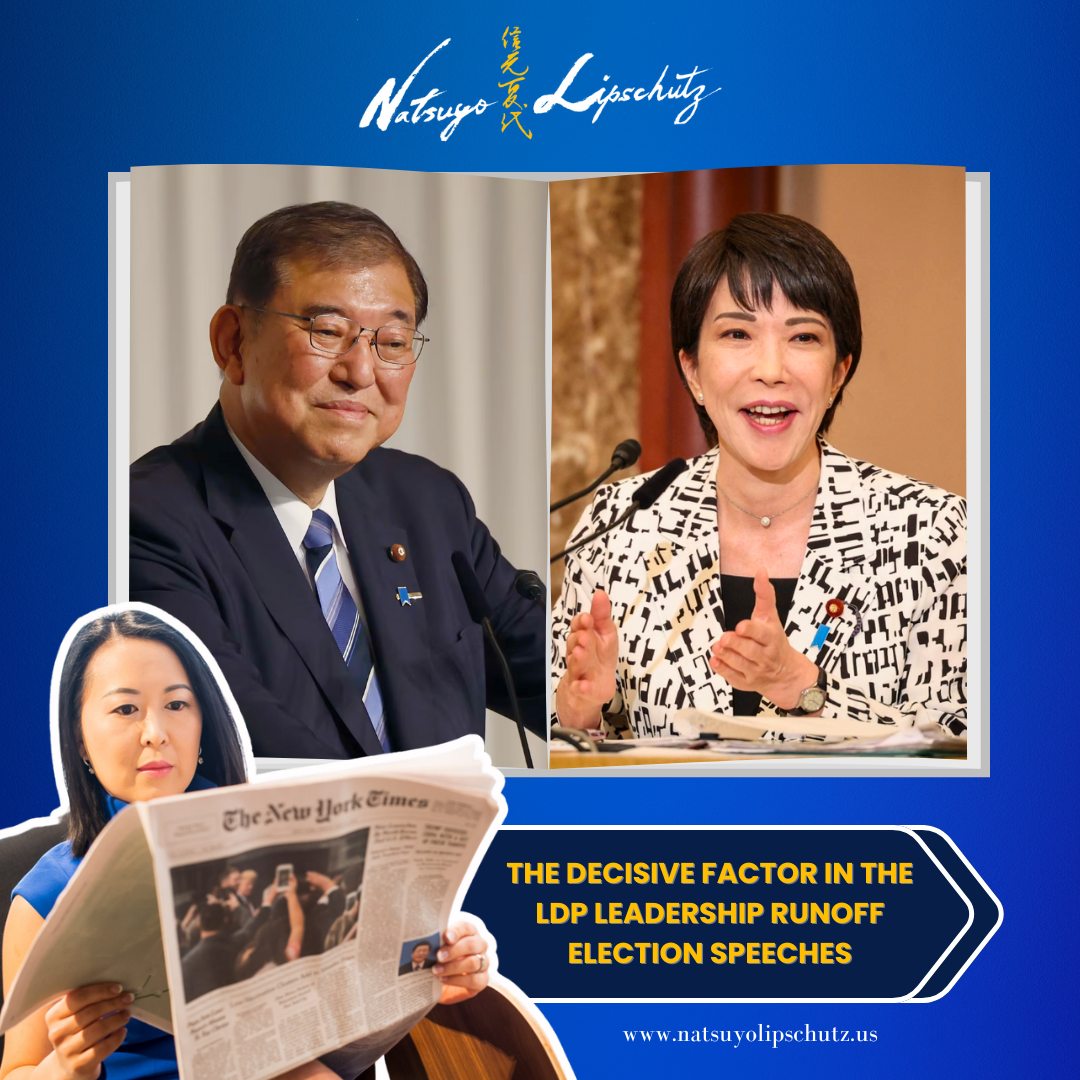
On September 27, 2024, Japan’s Liberal Democratic Party (LDP) held its leadership runoff election. Both candidates, Shigeru Ishiba and Sanae Takaichi, delivered their final speeches. The outcome was determined by one key factor. What was it? Let’s analyze by highlighting the striking differences between their speeches.
*Please note that this article is not an analysis of political views, policy content, or the reason for the election results, but rather an analysis of the speeches themselves.
Ishiba’s Steady Expression vs. Takaichi’s Warm Smiles
Ishiba spoke for just over five minutes, while Takaichi’s speech lasted about seven minutes. One of the most noticeable differences between these two short speeches was their facial expressions.
Throughout his speech, Ishiba maintained a serious expression, projecting a sense of strength and confidence. In contrast, Takaichi frequently smiled between her more serious moments, creating an impression of trustworthiness and approachability.
Though Ishiba’s expression remained unchanged, he showcased a rich vocal variety. His tone was sympathetic when referencing the Noto Peninsula Earthquake, gentle when recounting a story from a local summer festival 60 years ago, and powerful when making his closing statements. His voice crescendoed toward the end, amplifying the strength of his final message.
On the other hand, Takaichi maintained a steady tone throughout her speech. Unlike Ishiba, who used “I” frequently, Takaichi emphasized “We,” as in, “The feelings of the nine candidates were united as one”. She also engaged her audience by directly addressing them with phrases like, “Let us support each other, shall we?” and “Let us unite, shall we?”—creating a sense of togetherness with her listeners.
Ishiba’s Storytelling vs. Takaichi’s Lengthy Gratitude
At the start of her speech, Takaichi emphasized her unique advantage over her male opponent, stating, “As a woman, advancing to the runoff is a historic event for both the LDP and Japan.” However, after this opening, she spent a considerable amount of time expressing gratitude—to her supporters, Prime Minister Kishida, former party leaders, the nine other candidates, and their teams. Out of curiosity, I timed her, and I found out that nearly five of her seven minutes were devoted to giving thanks. This falls under the “Unpleasant Pleasantry” concept from my Breakthrough Method.
This concept describes a situation where, despite the speaker’s intent to show respect, the content may be irrelevant to the audience, making it seem inconsiderate of their interests (hence, “unpleasant”). Takaichi devoted about 70% of her speech to this “Unpleasant Pleasantry”, or, impolite courtesy.
This is a critical structural mistake.
Consequently, she lacked time to emphasize her “One Big Message®,” severely weakening the impact of her speech. This was a major factor in the speech’s downfall.
Ishiba, on the other hand, excelled in “structural contrast”—combining different elements in his speech to create variety. His speech structure was roughly as follows:
- Condolences for the Noto Peninsula disaster, gratitude, and a message of sympathy to Kishida: about 1 minute
- Showing vulnerability: about 1 minute
- Storytelling: about 1 minute
- Declaration of intent: about 2 minutes
Regarding his acknowledgment of his own vulnerability, Ishiba said:
“I have many shortcomings, having served as a lawmaker for 38 years. I must have hurt or offended many people. I sincerely apologize for my inadequacies. Throughout this election, I’ve learned a great deal. I have received many valuable lessons from the other candidates, who have taught me the way of the politician.”
Discussing one’s vulnerabilities, especially in such a critical setting, requires strength. In fact, Brené Brown, well-known for her TED Talk on vulnerability, stated:
“Vulnerability sounds like truth and feels like courage. Truth and courage aren’t always comfortable, but they’re never weakness.” – Brené Brown
Ishiba’s admission of his own “vulnerability” was an act of courage and strength. This likely resonated deeply with his audience.
Ishiba’s Clear Pyramid Structure vs. Takaichi’s Misaligned One Big Message®
Following his compelling storytelling, Ishiba solidified his message using a logical structure known as the “pyramid structure.” This method of structuring ideas contributed to the strength of Ishiba’s speech. His One Big Message® was “Protect Japan,” supported by three main points: “Protect the people,” “Protect the regions,” and “Protect the rules.” The logical and clear structure enhanced his speech’s persuasiveness.
His main points were as follows:
- One Big Message®: I want to protect Japan.
- Main Point 1: By protecting the people.
- Main Point 2: By protecting the regions.
- Main Point 3: By protecting the rules of the LDP.
Ishiba’s speech was logically sound and easy to follow. In contrast, Takaichi’s speech failed to allocate enough time to deliver a strong message, due to the time spent on her extended expressions of gratitude.
Ultimately, the decisive factor that determined the outcome of these speeches was the skillful structure of Ishiba’s speech. His clear and logical approach was a winning strategy in the LDP leadership runoff.
***
Read this article in Japanese: https://natsuyo-speech.media/speech-analysis/ldp_ishiba_takaichi/


